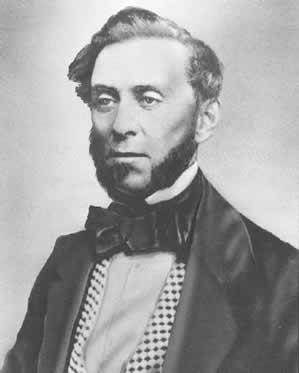Calistoga, Lodging Industry, People, Programs & Events
Sam Brannan

As part of our First Annual Napa Valley Lodging Industry Hall of Fame Ceremony, we have compiled a series of biographies of the historic inductees. This short history of Sam Brannan, written by Kathy Bazzoli of the Sharpsteen Museum, is the second of five articles.

This is a story of a Mormon soldier-of-fortune who ultimately spent hundreds of thousands of dollars to develop the upper Napa Valley springs grounds. In an effort to make it “the best spa in the world,” he began by purchasing a mere two square miles in the middle of town. By the time he was done, he owned more than 2000 acres.
It began innocently enough in the summer of 1852. Sam Brannan was only 33 years old and California’s first millionaire. Along with his wife, he vacationed at the White Sulphur Springs Resort in St. Helena. Brannan was so impressed with what he saw, he decided to further investigate the surrounding Hot Springs Township to the north. Traveling on horseback, he rode into what was a flourishing farming community. Seeing the abundance of the natural mineral springs and the hot water virtually spewing out of ground, in 1859 he returned to start building his dream.
Brannan must have been a sight to behold to the citizens of Hot Springs Township. He was a tall, darkly handsome, and resplendent figure with his tight buff trousers, brocaded waistcoat, heavy gold watch chain and his elaborately carved leather holster and Bowie knife. Known in some circles as somewhat of a “scoundrel,” hard-hitting, and tenacious, his business dealings being questionable at times, he was but an odd-looking stranger to those looking upon him for the first time.
Sam, being born and raised in the East, was more than familiar with the Saratoga Resorts of New York and was confident that he could build his resort to rival, and better, Saratoga.
By 1860, the first main building, a lavish 2-story hotel with adjoining dining hall, had been built. By the time the resort enjoyed its grand opening in 1862, more than 25 additional buildings had been erected, including 14 Brannan Cottages, all used as summer retreats. The larger cottages were five rooms, the smaller only three, yet each had a veranda, some with scalloped trim, others with mansard roofs and gingerbread across the eaves. All were complete with the finest furnishings available, and each with their own personal out-house. (There was no plumbing at that time, nor electricity, cottages were lit with kerosene lamps.)
With Mt. St. Helena as a grand backdrop to the resort, Sam had laid out a wide circular of beautiful, rose lined avenues, elaborately landscaped parks with “flowers of every kind to behold,” and individual bathing pavilions set about in the shape of miniature pagoda’s. The Hot Springs Hotel sat at the base of Mt. Lincoln with a broad, tree-lined avenue leading to the front steps. His private home, the 2-story Mansion House, sat nearby. Brannan also built an enormous bathhouse, skating rink and dance pavilion. High above it all, atop the hundred foot Mt. Lincoln, he built a tent shaped observatory with wide walkways and reached by a flight of wooden stairs. Beneath the observatory was a large, 90,000 gallon reservoir to hold water for the resort.
Brannan’s General Store, an express office, a swimming pool, a goldfish pond and Druidal Temple were all part of the original resort grounds. (The temple itself was 15 feet high and 25 feet in circumference.) A fence made of petrified wood was built surrounding the main concourse. Another 40 acres enclosed a mile-long race track and stables. Horses stabled here belonged not only to Sam, but to the likes of Stanford, Hearst, Kearney, Hopkins, and Lick.
A winery and Brandy distillery were built, acres of Mulberry trees planted for making silk, merino sheep were imported for another future endeavor, vineyards planted with the “choicest European and American varieties.”
Thousands came each season to Brannan’s Calistoga Springs Resort to “take the waters.” Visitors were also urged to take the “grape cure,” a remedy of persistently eating unadulterated grapes from the vine to better clean one’s system.
Saddle horses and carriages were available to rent for any days excursion. Visitors enjoyed scheduled day trips to outlying areas such as the Geysers, Petrified Forest, Howell Mountain, Pope Valley and St. Helena.
Due to Sam’s wife, Ann Eliza, wanting a divorce, by 1870 after extended court proceedings, Sam was ordered to pay Ann Eliza half of the community property. Brannan began liquidating his assets to comply, thus began his financial downfall. By 1875, Sacramento Savings Bank (holder of the mortgage on the resort) ordered the sale of all of Sam’s property in Calistoga, with the exception of the main resort, which was retained by Sam’s old friend, Leland Stanford.
About 1911, the resort was purchased by Jacques Pacheteau and renamed Patcheteau’s Hot Springs. Much of the original resort grounds is now owned by John & Pat Merchant and is called Indian Springs Resort.

